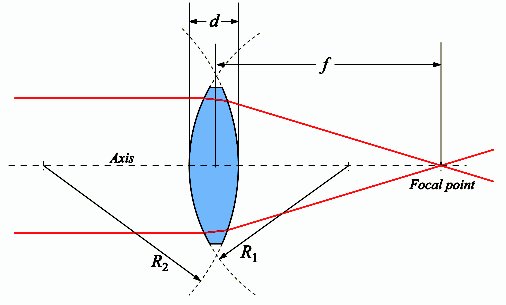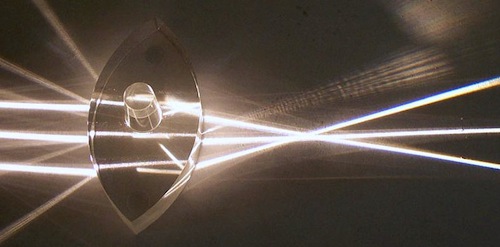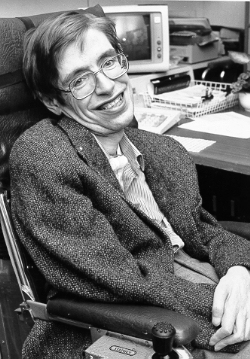
http://en.wikipedia.org/wiki/File:Lens1.svg
| HPS 0410 | Einstein for Everyone |
Back to main course page
John
D. Norton
Department of History and Philosophy of Science
University of Pittsburgh
| The distinctive feature of big bang cosmology is the big bang. We know it is there because when we project back the trajectories of the expanding galaxies and see that they all converge onto one point. It is somewhat like a lens focussing the rays of light of the sun. The rays emerge from the lens just perfectly aligned to focus to a single infinitely bright spot. |  http://en.wikipedia.org/wiki/File:Lens1.svg |
 http://en.wikipedia.org/wiki/File:Large_convex_lens.jpg |
Or that is what they would do in ideal circumstances. That is, if the light rays falling onto the lens were perfectly parallel and the lens perfectly constructed. In the real world, there are always slight unevennesses and neither of these assumptions hold. All that will happen is that the light is focussed to a very bright spot, not a point of infinite intensity. |
| Might the same be true of the big bang? Friedmann-Robertson-Walker spacetimes presume a perfectly uniform matter distribution. That means that all the motions of matter now are presumed symmetrically arranged so that, from the uniformity alone, if we project back into the past, we eventually come to a singular point. |
| That perfect uniformity is an idealization we
know is not true of our world. While the matter of the universe
might be nearly uniform when seen on some cosmic scale, locally it
is far from uniform. When we allow for these non-uniformities might
we not have a big bang--a true singularity--but merely a region of
spacetime with a lot of near misses? So instead of the big bang, we
have a temporary region of very high density?
If that happened, the big bang would no longer be the beginning of
time. There would be time and matter and space before the big bang.
The big bang would merely be an extremely hot phase of highly
compressed matter and space in the overall history of the cosmos.
Might the big bang merely be an unrealistic artefact of an unrealistic symmetry assumption? For the big bang to be physically interesting to us, its existence must be assured robustly by physical principles, not fragile assumptions of uniformity. |
 http://commons.wikimedia.org/wiki/File:Stephen_Hawking.StarChild.jpg |
It was long supposed that non-uniformities might preclude a true singularity. In the 1960s, when a group of mathematical physicists turned to this and related issues, it was soon shown that this supposition was wrong.There was a great deal more inevitability to the big bang. The results were delivered in the form of mathematical theorems within the framework of general relativity. They show that, under quite broad conditions, even with non-uniformity, a singularity is inevitable. Here is one of a number of these theorems proved by Stephen Hawking |
.
| IF | |
| (a) the universe is expanding at some instant
("now"); |
|
| (b) the rate of expansion is now everywhere
greater than some fixed positive amount "K"; |
Note that this expansion need not be uniform. It can be high in one place and low in another. It just must be everywhere greater than some positive amount K. This "K" can be anything, but it must be greater than zero. |
| (c) Einstein's gravitational field equations (without λ) hold with the "strong energy condition"; | Recall that the notion of "matter density" in general relativity
is complicated. Energy contributes to it, but so do stresses. Indeed
stresses can be sources of the gravitational field. The "strong
energy condition" requires that the contribution to matter from
ordinary energy is greater than that from stresses. So this
condition says "not too much funny matter."
Notice that there is no condition that the matter distribution be uniform or even that there be matter everywhere. |
| (d) there are no causally isolated pockets of spacetime in the universe; | The technical requirement is that the spatial slice "now" be a Cauchy surface. A Cauchy surface has the property that every non-terminating physical process, propagating at or less than the speed of light, must pass through it exactly once. So any process in the surface's past will end up intersecting it; and any process in its future must have passed through it. Specifying the state of a Cauchy surface fixes the future and past geometric state of the spacetime fully. That a spacetime have a Cauchy surface is a strong condition not satisfied by many spacetimes. The hypersurfaces of simultaneity of a Minkowski spacetime and the natural spatial slices of a Friedmann-Robertson-Walker spacetime representing the "nows" are Cauchy surfaces. |
| THEN |
|
| no timelike world line can be extended indefinitely into the past; that is, no timelike curve has greater temporal length than 3/K. |
The "THEN" conclusion in effect tells us that there is something pathological going on in our past. If we try to trace the history of a galaxy--one case of a timelike world line--indefinitely into the past, something blocks it. Such world lines cannot extend back arbitrarily. You might complain that this is an oblique way of characterizing a singularity. That is true, but that is how these matters are dealt with. Recall that a singularity is not a point in the spacetime, so its identification will have to be indirect.
We can get a more intuitive sense of how the theorems work by recalling the jig saw puzzle analogy for solving Einstein's equations. We specify the "now" part of spacetime in accord with the "IF" conditions above. We then try to reconstruct the spacetime of the past by solving Einstein's gravitational field equations; that is, we start to put in the pieces of spacetime that fill out the past. What we discover is that we can only keep adding in pieces for some finite distance in time to the past. Then we can go no further.
The strength of a theorem is that it is a mathematically proven result. As long as the "IF" conditions are met, the "THEN" conclusion is forced by mathematics alone. That is also the weakness. The "IF" conditions may fail. Indeed stating a theorem like this is an invitation to troublemakers to find failures of the IF condition.
They certainly can be found.
• If there are black holes, then the causal niceness condition (d) is
violated.
• As we discover more and more exotic forms of matter in the cosmos, we
may worry about the energy condition (c).
• If Einstein's cosmological constant λ is large enough so that its
repulsive powers overwhelm the attractive powers of ordinary matter, then
it turns out that we can have a cosmology with no big bang and no big
crunch. Space slowly collapses over time to some minimum size and then
expands out again. It is a single gentle bounce.
Copyright John D. Norton. March 2001; January 2007, February 16, 23, October 16, November 10, 2008, March 31, 2010; January 1, 2013; March 18, 2015. February 5, March 24, 2022.